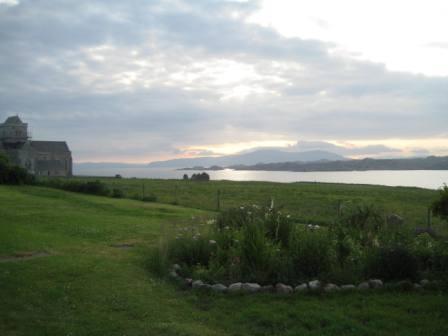
The ferry from Iona to Mull
Some of you may be wondering where Iona is and what makes it worth the long and sometimes tedious travel by plane, bus and ferry boats. Here is a little bit of information to whet your appetite. There are lots of websites and books if you want to know more from more reliable sources.
Iona is a tiny island off the west coast of Scotland. When I say tiny, I mean tiny. The speck of land is a walkable three miles long and a bit over one mile wide.
In Gaelic, Iona is “I Chaluim Chille,” which means the “isle of Columcille.” Today Columcille is known as St. Columba, an Irish priest who brought Celtic Christianity to Scotland in 563 AD. There are many stories about why Columba left Ireland. In one version,the priest left Ireland over a legal scandal. The story goes that a wealthy nobleman had hired Columba to transcribe passages of scripture. When the work was completed, Columba claimed that the text belonged to him. Of course, the noble man who had paid Columba to do the work disagreed. The court sided with Columba’s patron and the priest left his beloved Ireland in disgrace.
Columba and 12 monks sailed from Ireland in coracles, lightweight row boats. Joyce Watson, an Iona resident who led me and some of my fellow Shalem pilgrims on a day hike to St. Columba’s Bay, told us that Columba was determined to sail far enough away so that he would be unable to see Ireland from his new home land. When he came ashore on the south end of Iona, he climbed a rise in the land and declared that they were home because he was unable to see Ireland. Joyce thinks that Columba may have landed on Iona on an overcast day because, today, on a clear day, one can indeed see Ireland from a high point on the island.
Columba died just four years after coming to Iona. However, his missionary work spread throughout Scotland and into other parts of Europe as his followers brought Celtic Christianity to the Druids and other followers of pre-Christian practices.
Driven out of Iona by Viking raids, most of the monastic community founded by Columba moved to Ireland around 800 AD. Around 1200 AD, a Benedictine abbey and an Augustinian nunnery were established on Iona. The nunnery ruins are still visible.
Iona Abbey was dissolved during the Protestant Reformation in the 17th century and fell into ruin. Restoration of the Abbey began at the beginning of the 20th century by a duke of Argyll. The duke’s work was continued by George MacLeod in the 1930s. Inspired by the Celtic tradition of early Iona, MacLeod, a Scottish minister, founded the ecumenical Iona Community in 1938. This project brought together newly ordained ministers and skilled craftsmen who were out of work during the Depression. Together, the clergy and the workmen rebuilt the Abbey while learning how to communicate about spiritual and practical matters.
Today, Iona is home to 120 year round residents and the ecumenical Iona Community. The island remains a place of Christian pilgrimage as it has been for the more than 1400 years since Columba arrived.
The only way to reach Iona is on a passenger ferry form Fionnphort on the Isle of Mull. The ferry delivers visitors to and from Iona throughout the daylight hours. There are a few farm trucks and a couple of passenger vehicles on the island for residents and a taxi to transport guests from the ferry to the few hotels and B&Bs on Iona.
When the last ferry leaves at the end of the day, Iona is still. As the sun sets, the only sounds on the island are voices in worship at the Abbey and the song of the surf, cuckoos, cows and sheep.

No comments:
Post a Comment